Peer Review All Life Has a Family Tree
Commercials abound for Deoxyribonucleic acid testing services that volition assist you learn where your ancestors came from or connect you with relatives. I've been interested in my family unit history for a long time. I knew basically where our roots were: the British Isles, Germany and Hungary. Simply the ads tempted me to dive deeper.
Previous experience taught me that different genetic testing companies can yield different results (SN: 5/26/xviii, p. 28). And I knew that a company tin match people simply to relatives in its customer base of operations, so if I wanted to find as many relatives as possible, I would need to apply multiple companies. I sent my Dna to Living Dna, Family Tree DNA, 23andMe and AncestryDNA. I also bought the National Geographic Geno ii.0 app through the visitor Helix. Helix read, or sequenced, my Dna, then sent the data to National Geographic to analyze.
These companies analyze hundreds of thousands of natural Dna spelling variations called unmarried nucleotide polymorphisms, or SNPs. To estimate indigenous makeup, a company compares your overall SNP pattern with those of people from around the earth. SNP matches also aid companies see who in their database yous're related to.
Some of the companies also clarify a person's Y chromosome or mitochondrial Dna. Y chromosome Dna traces a human being's paternal line. In contrast, mitochondrial DNA traces maternal heritage, since people inherit mitochondria, which generate energy for cells, only from their mothers. Neither type of Deoxyribonucleic acid changes that much over time, and so those tests unremarkably can't tell you much virtually recent ancestors.
Once I sent in DNA samples, my Spider web-based results arrived in but a few weeks. Simply my user experience, and results, were quite different for each company.
National Geographic Geno two.0
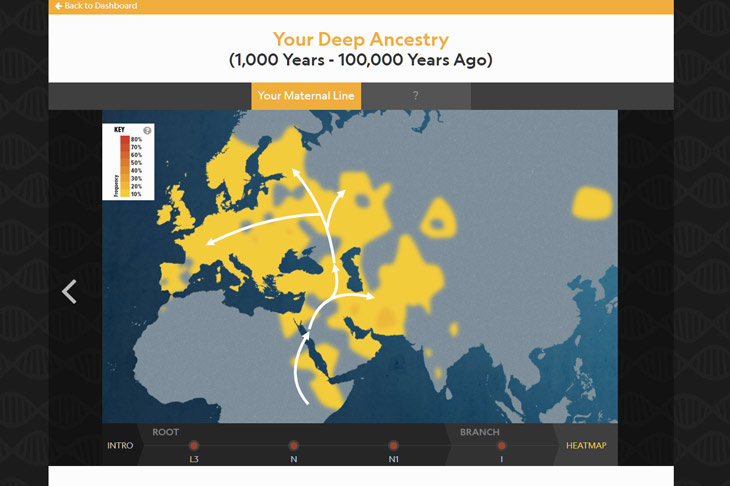
At $199.95, National Geographic's examination is the most expensive, all the same the least useful. The results are generic, and the ethnicity categories are overly broad. My results say that 45 percent of my heritage came from people living in southwestern Europe 500 to 10,000 years ago. That doesn't tell me much and doesn't reflect what I know of my family history.
There's no relative matching, though Geno 2.0 shows which historical "geniuses" may accept shared your mitochondrial or Y chromosome DNA. I don't know how National Geographic knows virtually the mitochondria of Petrarch, Copernicus or Abraham Lincoln. And then I'm skeptical that I am actually related to those famous figures, even from the distance of 65,000 years, the last time we supposedly had an ancestor in mutual. The service too calculated the pct of Neandertal ancestry that I conduct. I take geeky pride that 1.5 percent of my DNA comes from Neandertals, topping the 1.3 percent boilerplate for Geno ii.0 customers.
Overall, Geno 2.0 has a overnice presentation, only I learned more than about my family history elsewhere. Since I bought the Geno 2.0 kit as an app through Helix, I don't know if the kit purchased directly from National Geographic, which is candy past Family Tree Dna, would yield different results.
Living Deoxyribonucleic acid
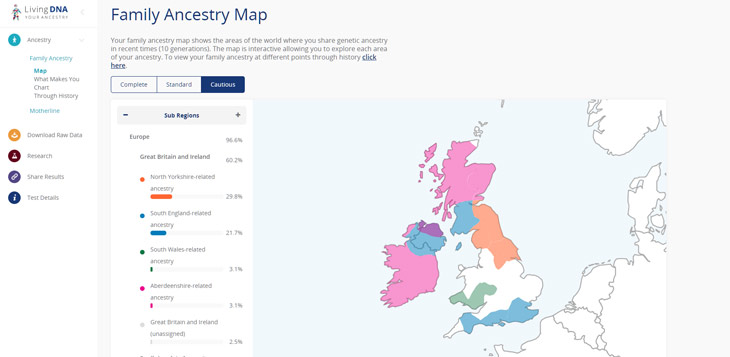
Another expensive test ($159) came from Living DNA. When I saw the visitor'southward advertisement challenge to pinpoint exactly where in the British Isles a person's genetic roots stalk from, I decided to requite information technology a go. The visitor highlights ethnicity on a world map, then lets you zoom in from the continent level. I found that 22.five percent of my heritage came from Lincolnshire in east-central England. I haven't nevertheless traced whatsoever ancestors to Lincolnshire, but I did observe through much genealogical sleuthing that one of my sixth-dandy-grandfathers came from Aberdeen, Scotland. Living DNA says that 3.1 pct of my DNA is from Aberdeenshire. Written narratives on the website provide a history of each reported region.
Using mitochondrial Dna and, if applicative, Y chromosome DNA, the company can trace your maternal and paternal lines dorsum to homo origins in Africa and show where and when your particular line probably branched off the original. My "motherline" probably arose in the Near East xix,000 to 26,000 years agone, Living Deoxyribonucleic acid claims, and my ancestors were some of the first people to enter Europe. In February, the company appear that it would soon launch a relative-matching service for its customers.
I'm non sure the service would be worth the price tag for people whose ancestry doesn't contain a strong British or Irish tilt, though Living Dna says it is working to improve ethnicity estimates in Federal republic of germany and elsewhere.
Family Tree Dna
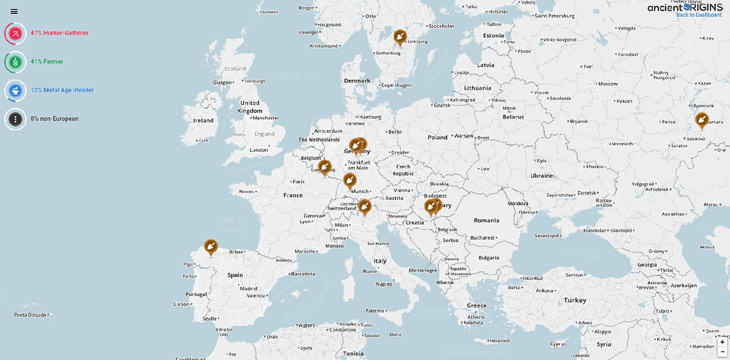
The most no-frills of the agglomeration is Family unit Tree DNA. For $79, "autosomal" testing looks for genetic variants on all of the chromosomes except the X and Y sexual practice chromosomes. Y chromosome and mitochondrial Deoxyribonucleic acid assay costs extra.
Family Tree Deoxyribonucleic acid allows a user to build a family tree, incorporating personal Deoxyribonucleic acid tests and matches from the site'due south relative-matching department. I constitute more than 2,400 potential relatives. A chromosome viewer lets me see exactly which scrap of Dna I have in common with any particular relative, or with up to 5 relatives at a time. That feature also allows users to trace how they inherited DNA from a shared ancestor. Just I found this tool hard to use.
The website offers little explanation of results. For case, I was excited to see that my Deoxyribonucleic acid was compared with that of ancient Europeans, including Ötzi the Iceman, who lived five,300 years ago (SN: 9/17/16, p. 9). Family Tree DNA is the only company I tried that incorporates aboriginal DNA into its results and that feature was what convinced me try this company. I did go a breakdown of how different groups — Stone Age hunter-gatherers, early farmers and "Metallic Age Invaders" from the Eurasian steppes — contributed to my DNA. Just when I saw Ötzi's dot on my beginnings map, it wasn't articulate if that meant we share DNA or if the map was merely showing where he lived.
23andMe
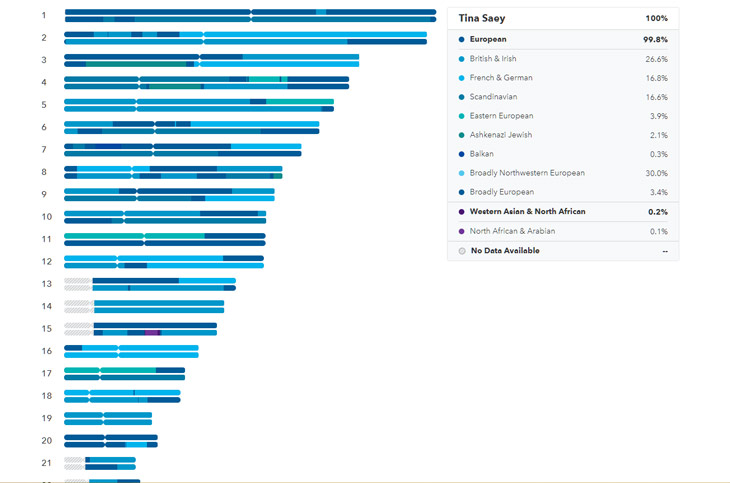
23andMe ($99) offers one of the more than complete packages of data. Most companies show a map of ethnic heritage. 23andMe does, likewise, but also presents an interactive diagram of all of a person'south chromosomes, indicating which portions carry a detail ethnic ancestry. Because my parents also did 23andMe, I learned that my dad handed me a tiny bit of chromosome 15 that carries western Asian and northern African heritage. My mom gave me the 0.3 percentage of my DNA that comes from the Balkans, in a single chunk on chromosome seven, which makes sense since her grandparents came from Hungary. Playing with the chromosomes is fun. Only I question the accuracy of these results (see my related article for more than on why ancestry tests may miss the mark).
23andMe presents Neandertal heritage in terms of the number of genetic variants y'all carry. A family-and-friends scoreboard shows where yous stack up. (I meridian my leaderboard with 296 Neandertal variants, more what 80 percent of 23andMe customers take.) The report besides explains what some of those Neandertal variants do, including ones linked to back pilus, straight hair, summit and whether yous're probable to sneeze afterwards eating dark chocolate. The company doesn't test for all possible Neandertal variants, including ones that have been linked to health (SN Online: 10/10/17; SN: three/5/16, p. 18).
Like Geno 2.0, 23andMe uses mitochondrial and Y chromosome Deoxyribonucleic acid to trace the migration patterns of a person's ancestors, from Africa to the present day.
Relative matching is both interesting and frustrating. I could see the people I match, how we might be related and compare our chromosomes. But 23andMe doesn't provide a way to build family unit trees to farther explore these relationships.
AncestryDNA
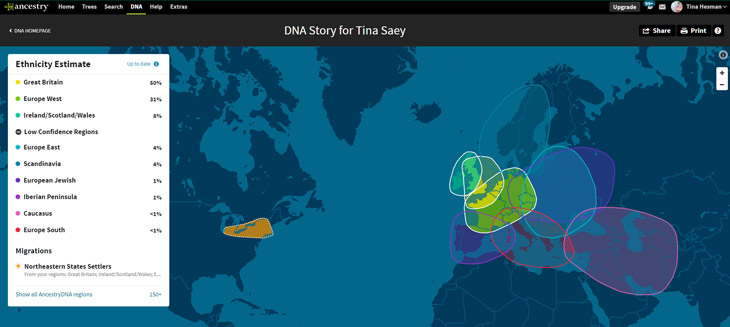
AncestryDNA ($99) doesn't give the variety of data other companies exercise. But it has useful genealogical tools, provided you link your results to a family unit tree that you can build with assistance from historical records via a paid subscription to Ancestry.com.
One interesting feature of my heritage study was that it went beyond spots on the map in Europe to also prove a region of the U.s.a. chosen "Northeastern States Settlers." A match to that category tells me that my ancestors who came from Europe probably initially settled in New England or around the Groovy Lakes. They did. 1 co-operative of my family tree fix roots in Massachusetts in the 1640s. Using nativity, death and immigrant records from Beginnings.com, I could build a timeline to evidence when and from where private ancestors immigrated to the The states.
AncestryDNA also matches y'all with relatives, just you can but see how you lot're related to those people if they accept besides chosen to make family trees.
A characteristic unique to AncestryDNA is called DNA circles. It shows connections between individuals and family unit groups who share Dna with you. These circles also incorporate descendants of your ancestors who you don't straight share DNA with. Therefore, this characteristic allows y'all to extend relative matches beyond what traditional Deoxyribonucleic acid matching can do.
For instance, I am in a family group with my uncle and a cousin. We all share Dna with 24 other descendants of Samuel Pickerill, a drummer during the Revolutionary War. Pickerill has 42 other descendants with whom my family group doesn't share DNA. Those 42 Pickerill descendants happened to inherit unlike bits of DNA from Pickerill than my uncle, his cousin and I did. That sometimes happens because of the random nature of the rules of biology and genetics (for more on those rules, cheque out this video).
Genealogy junkie
Although I've always been interested in family history, DNA testing has gotten me hooked on genealogy research.
23andMe and AncestryDNA were the near fun to use. 23andMe can tell me whether a relative is on my female parent's or father'south side of the family. Merely then I have to go back to AncestryDNA and comb through my family tree to learn how we're really connected. DNA tin kick-start a genealogy chase, but combing through marriage certificates, military machine rolls, census records, immigration documents, quondam photographs and other records — which Ancestry.com can provide — is what really tells me who my ancestors were.
Source: https://www.sciencenews.org/article/family-dna-ancestry-tests-review-comparison